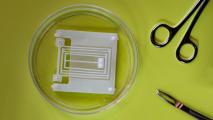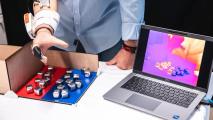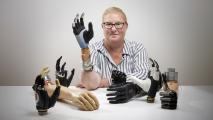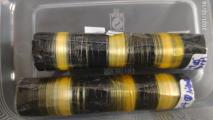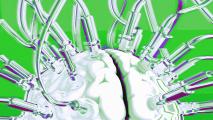Scientists still haven’t built a prosthetic eye. Too much of how the brain perceives the world around us is still a mystery. But new research brings us one step closer to the technology that could restore vision to blind people.
Researchers at the Baylor College of Medicine in Huston have learned how to bypass the optic nerve and send visual information straight to the brain, helping blind people “see” shapes — many for the first time in years or decades.
The visual cortex is the part of the brain that processes information from the eyes. Scientists have known for decades that if you artificially activate it with a small electrical pulse, you can stimulate the brain to create a phosphene, a spec of light floating through your field of vision. Phosphenes aren’t real objects, but people can “see” them in their minds. Although promising, it wasn’t enough to lead to a functional prosthetic eye.
Researchers thought that by stimulating many areas on the visual cortex, the specs of light will come together to make a shape — much like pixels on an LCD screen form a picture. But no one has been able to prove that theory works. Too often, participants in the study would see many phosphenes, but they would not form a coherent shape.
Advancements Toward a Prosthetic Eye
Inspired by the possibility of someday creating a prosthetic eye, neurobiologist Daniel Yoshor and his team decided to take a different approach, an experiment recently published in the journal Cell. Using an array of electrodes on the visual cortex, they moved an electrical current across the brain in a sweeping motion, literally tracing out letters of the alphabet. Incredibly, the study participants saw the letters in their mind’s eye and were able to recreate them on a touch screen.
“Their reaction, of course, was a lot of smiles. These are patients who haven’t seen for a minimum of several years. They were at least as excited as we were when we saw that it worked. We were very excited — excited for the patients excited for the future,” Yoshor says.
Yoshor worked with two patient groups — sighted and blind. The sighted group already had electrodes implanted in their brain to monitor epilepsy, while the blind participants had electrodes at the visual cortex for a different study. By stimulating the electrodes in a sequence, like a “connect the dots” pattern — rather than all at once — the participants could correctly ID the letters they were being sent.
Researchers don’t know precisely why stimulating the electrodes in sequences versus simultaneously creates a picture in the mind’s eye. Much of what we discern in the world is because of how the brain processes information from the eyes, rather than just a reflection of the image onto the retina.
Yoshor likened the difference to how someone perceives letters traced on their hand. If someone draws the shape of the letter on your hand, rather than pressing the shape on all at once, you’re more likely to be able to tell what letter it is.
“The work itself is really good and exciting and basically showing that you can create these patterns by rapidly stimulating one electrode after another,” says Ione Fine, a psychologist at the University of Washington.
“It means that cortical impacts produce predictable phosphenes that can be made into shapes. And that’s the fundamental thing you need to build an implant that people can use to make a useful vision impact.”
Fine uses computational models, which she calls “virtual patients,” to understand the neurophysiological basis of visual processing. She does not work with Yoshor or his team, but after reading an early copy of their experiment, she spent the next three weeks testing it with her virtual patients. Her model supported Yoshor’s findings.
While the shapes being stimulated now are rudimentary, this work brings us one step closer to a future where blind people can have functional vision again using a prosthetic eye.
Someday researchers could create a camera that collects visual information from the outside world, decodes it, and inputs it into the neurons in the brain — essentially bypassing a damaged optic nerve. Yoshor thinks this could be a reality within the next decade. But the next step would be to increase the number of electrodes implanted on the visual cortex and expand the effort.
“We have to be visionary and looking ahead,” he says. “The power, the capability that is latent in the brain, is immense. It’s just a matter of understanding the science of vision better and enhancing the technology that we use to interface with the brain.”
We’d love to hear from you! If you have a comment about this article or if you have a tip for a future Freethink story, please email us at [email protected]

